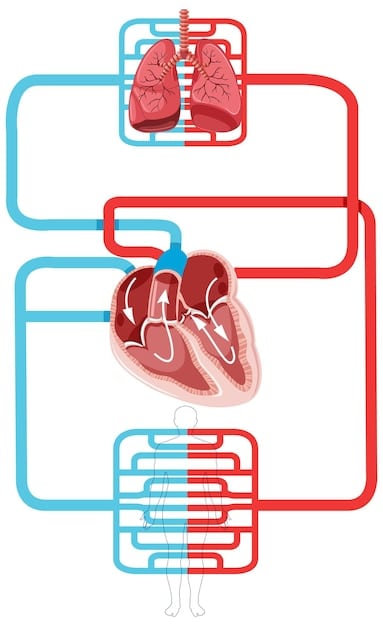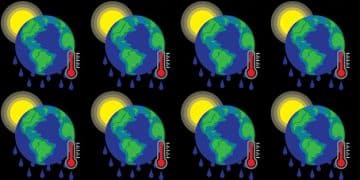Air Pollution: Unveiling Health Impacts & Mitigation Strategies

Air pollution significantly impacts human health, contributing to respiratory illnesses, cardiovascular diseases, and even cancer, necessitating effective mitigation strategies to protect public health.
How does air pollution affect human health? A review of the scientific evidence and mitigation strategies reveals a pressing concern as we breathe in a cocktail of pollutants daily. These pollutants, from vehicle emissions to industrial processes, are more than just a nuisance; they pose a significant threat to our well-being.
Understanding the Scope of Air Pollution and Its Sources
Air pollution is a complex issue with far-reaching consequences for human health. It encompasses a variety of pollutants from numerous sources, each contributing uniquely to the overall problem. By understanding the scope and sources of air pollution, we can better grasp its pervasive impact on our well-being.
Major Types of Air Pollutants
Air pollutants can be broadly categorized into several major types, each with distinct chemical compositions and sources.
- Particulate matter (PM): This refers to the tiny particles suspended in the air, including dust, soot, and smoke. PM is often classified by size, with PM2.5 (particles with a diameter of 2.5 micrometers or less) being particularly harmful as it can penetrate deep into the lungs.
- Nitrogen oxides (NOx): These gases are primarily produced from the burning of fossil fuels, especially in vehicles and power plants. Nitrogen dioxide (NO2) is a major component of NOx and contributes to smog and acid rain.
- Sulfur dioxide (SO2): Mainly released from the burning of fossil fuels containing sulfur, SO2 is a significant contributor to respiratory problems and acid rain.
- Ozone (O3): While beneficial in the upper atmosphere, ground-level ozone is a harmful pollutant formed when NOx and volatile organic compounds (VOCs) react in the presence of sunlight.
These pollutants, often invisible to the naked eye, collectively contribute to a degraded air quality that can have severe health implications.

The sources of air pollution are varied and widespread, ranging from industrial activities to natural processes.
- Industrial emissions: Factories and manufacturing plants release a variety of pollutants, including particulate matter, sulfur dioxide, and heavy metals. These emissions can contribute significantly to local and regional air pollution levels.
- Vehicle emissions: Cars, trucks, and other vehicles are major sources of nitrogen oxides, particulate matter, and carbon monoxide. The combustion of gasoline and diesel fuel releases these pollutants into the atmosphere, particularly in urban areas.
- Agricultural activities: Farming practices such as the use of fertilizers and pesticides can release ammonia and other harmful chemicals into the air. Additionally, dust from plowing and harvesting can contribute to particulate matter pollution.
Understanding these sources is crucial for designing effective mitigation strategies and policies aimed at reducing air pollution.
In summary, air pollution is a complex issue stemming from multiple sources, encompassing a range of pollutants that significantly affect human health. Recognizing these factors is the first step towards developing effective strategies to mitigate its impact.
Respiratory Health and Air Pollution: A Direct Link
The respiratory system is particularly vulnerable to the harmful effects of air pollution. The direct exposure of the lungs to airborne pollutants can trigger a range of respiratory illnesses and exacerbate existing conditions. The link between respiratory health and air pollution is well-documented and a major public health concern.
The Impact on Asthma
Asthma, a chronic respiratory disease characterized by inflammation and narrowing of the airways, is significantly affected by air pollution. Exposure to pollutants can trigger asthma attacks and worsen symptoms.
Several studies have shown that increased levels of particulate matter, nitrogen dioxide, and ozone can lead to a higher incidence of asthma exacerbations. These pollutants irritate the airways, causing inflammation and increasing the sensitivity of the lungs to triggers such as allergens and infections. This can result in more frequent and severe asthma attacks, leading to increased hospital visits and a reduced quality of life for those with asthma.
Chronic Obstructive Pulmonary Disease (COPD)
COPD, another chronic respiratory disease that includes conditions like emphysema and chronic bronchitis, is also closely linked to air pollution. Long-term exposure to pollutants can contribute to the development and progression of COPD.
Air pollution can damage the lung tissue and impair the ability of the airways to clear mucus, leading to chronic inflammation and airflow limitation. Pollutants such as particulate matter and sulfur dioxide can exacerbate COPD symptoms, causing shortness of breath, coughing, and increased mucus production. Over time, this can lead to a decline in lung function and a higher risk of respiratory infections.
Increased Risk of Respiratory Infections
Exposure to air pollution can weaken the immune system and increase susceptibility to respiratory infections such as bronchitis and pneumonia. Pollutants can damage the cells lining the respiratory tract, making it easier for viruses and bacteria to invade and cause infection.
Children and the elderly are particularly vulnerable to these effects. Studies have shown that children living in areas with high levels of air pollution have a higher risk of developing respiratory infections and experiencing more severe symptoms. Similarly, older adults with pre-existing respiratory conditions are more likely to experience complications from respiratory infections when exposed to air pollution.
In conclusion, the respiratory system is directly and adversely affected by air pollution. From triggering asthma attacks to contributing to COPD and increasing the risk of respiratory infections, the evidence clearly demonstrates the need for measures to reduce air pollution and protect respiratory health.
Cardiovascular Diseases and Air Quality: An Emerging Threat
While respiratory illnesses are the most commonly recognized consequence of air pollution, cardiovascular diseases represent another significant health risk. Emerging research has increasingly linked poor air quality to various cardiovascular problems, highlighting a new dimension of concern.
Mechanisms Linking Air Pollution to Cardiovascular Diseases
Air pollution affects cardiovascular health through several key mechanisms.
- Inflammation: Inhaled pollutants can trigger systemic inflammation, which damages blood vessels and promotes plaque buildup.
- Oxidative Stress: Exposure to pollutants increases oxidative stress, leading to endothelial dysfunction, which impairs the ability of blood vessels to dilate properly.
- Blood Coagulation: Air pollution can increase blood coagulation, raising the risk of blood clots and cardiovascular events.
These mechanisms contribute to the development and progression of various cardiovascular diseases, making air pollution a significant risk factor.
Increased Risk of Heart Attacks and Strokes
Several studies have demonstrated a direct link between air pollution and an increased risk of heart attacks and strokes.
Short-term exposure to high levels of particulate matter has been associated with a higher incidence of heart attacks, particularly among individuals with pre-existing cardiovascular conditions. Similarly, long-term exposure to air pollution can increase the risk of stroke by promoting atherosclerosis, the buildup of plaque in the arteries. These findings underscore the immediate and long-term threats posed by air pollution to cardiovascular health.
Hypertension and Arrhythmias
Air pollution has also been linked to hypertension (high blood pressure) and arrhythmias (irregular heartbeats).
Exposure to pollutants can impair the function of the blood vessels, leading to an increase in blood pressure. Additionally, air pollution can disrupt the electrical activity of the heart, causing arrhythmias that can increase the risk of sudden cardiac arrest. These effects are particularly concerning for individuals with pre-existing cardiovascular conditions or those at risk of developing them.

In summary, cardiovascular diseases represent a significant health threat associated with air pollution. From increasing the risk of heart attacks and strokes to contributing to hypertension and arrhythmias, the evidence clearly demonstrates the need for measures to reduce air pollution and protect cardiovascular health.
Air Pollution and Cancer: Unveiling the Carcinogenic Risks
The association between air pollution and cancer is a growing area of concern, with a significant body of evidence linking exposure to certain air pollutants with an increased risk of various types of cancer. Understanding these risks is crucial for implementing effective preventive measures.
Known Carcinogens in Air Pollution
Several air pollutants have been identified as known or probable carcinogens by international health organizations.
- Particulate Matter (PM2.5): Classified as a Group 1 carcinogen by the International Agency for Research on Cancer (IARC), PM2.5 is known to cause lung cancer.
- Diesel Exhaust: Also classified as a Group 1 carcinogen by IARC, diesel exhaust contains a complex mixture of pollutants, including particulate matter and polycyclic aromatic hydrocarbons (PAHs), which are linked to lung cancer and other cancers.
Increased Risk of Lung Cancer
Numerous studies have consistently shown a link between long-term exposure to air pollution and an increased risk of lung cancer. Particulate matter and diesel exhaust are among the most significant contributors to this risk.
Exposure to these pollutants can damage the DNA in lung cells, leading to mutations that can cause cancer. Additionally, air pollution can promote inflammation in the lungs, creating an environment that is conducive to the development and progression of cancer. The risk of lung cancer is particularly elevated among individuals who are exposed to high levels of air pollution over a prolonged period.
Other Cancers Linked to Air Pollution
In addition to lung cancer, emerging evidence suggests that air pollution may also be associated with an increased risk of other types of cancer.
Studies have linked exposure to air pollution with a higher incidence of bladder cancer, particularly among individuals who are also exposed to other risk factors such as smoking. Additionally, some research has suggested a possible link between air pollution and breast cancer, although more research is needed to confirm this association. The potential for air pollution to contribute to multiple types of cancer underscores the broad health implications of poor air quality.
In conclusion, the carcinogenic risks associated with air pollution are a significant public health concern. From increasing the risk of lung cancer to potentially contributing to other types of cancer, the evidence highlights the need for measures to reduce exposure to carcinogenic air pollutants and protect public health.
Strategies for Mitigating Air Pollution: A Comprehensive Approach
Mitigating air pollution requires a comprehensive approach involving various strategies at the individual, community, and governmental levels. Effective mitigation strategies can significantly reduce air pollution and protect public health.
Individual Actions to Reduce Air Pollution
Individual actions can play a critical role in reducing air pollution.
- Use Public Transportation: Opting for public transportation, biking, or walking instead of driving can reduce vehicle emissions.
- Drive Efficiently: Maintaining your vehicle, driving at moderate speeds, and avoiding unnecessary idling can lower emissions.
- Conserve Energy: Reducing energy consumption at home by using energy-efficient appliances and turning off lights when not needed can decrease the demand for power plants that contribute to air pollution.
By incorporating these practices into daily life, individuals can contribute to cleaner air and a healthier environment.
Community-Based Initiatives
Community-based initiatives can enhance air quality by promoting sustainable practices and raising awareness.
Communities can establish local programs to encourage the use of public transportation, promote the planting of trees and green spaces, and educate residents about the health risks of air pollution. Additionally, community groups can advocate for policies that support cleaner air, such as the development of bike lanes and pedestrian-friendly streets.
Governmental Policies and Regulations
Governmental policies and regulations are essential for addressing air pollution on a larger scale.
Governments can implement stricter emission standards for vehicles and industries, promote the use of renewable energy sources, and enforce regulations to reduce air pollution from construction sites and agricultural activities. Additionally, governments can invest in public transportation infrastructure and provide incentives for businesses and individuals to adopt cleaner technologies. Effective policies and regulations are critical for achieving significant and lasting improvements in air quality.
The Role of Technology and Innovation in Air Quality Management
Technology and innovation play a crucial role in air quality management, offering new tools and methods to monitor, analyze, and reduce air pollution. Embracing these advancements can lead to more effective strategies for protecting public health and the environment.
Advanced Air Quality Monitoring Systems
Advanced air quality monitoring systems provide real-time data on pollution levels, enabling timely interventions
- Satellite Monitoring: Satellites equipped with advanced sensors can track air pollution on a global scale, providing valuable data for monitoring and analysis.
- Sensor Networks: Networks of ground-based sensors can provide localized, real-time data on air pollution levels, helping to identify pollution hotspots and assess the effectiveness of mitigation strategies.
Clean Energy Technologies
Clean energy technologies offer sustainable alternatives to fossil fuels, significantly reducing air pollution.
Renewable energy sources such as solar, wind, and hydroelectric power produce little to no air pollution, making them ideal replacements for fossil fuel-based power plants. Additionally, technologies such as electric vehicles and hydrogen fuel cells can reduce emissions from the transportation sector. By investing in and promoting clean energy technologies, we can reduce air pollution and create a cleaner, healthier environment.
Innovative Air Purification Methods
Innovative air purification methods can remove pollutants from the air, improving air quality in indoor and outdoor environments.
Technologies such as air purifiers with HEPA filters and activated carbon can effectively remove particulate matter, gases, and odors from indoor air. Additionally, researchers are developing innovative methods for removing pollutants from outdoor air, such as photocatalytic coatings that break down pollutants in the presence of sunlight. These technologies offer promising solutions for improving air quality in both indoor and outdoor environments.
In summary, technology and innovation are essential for effective air quality management. From advanced monitoring systems to clean energy technologies and innovative air purification methods, these advancements offer new tools for reducing air pollution and protecting public health.
Future Directions in Air Pollution Research and Policy
Addressing air pollution effectively requires ongoing research and the development of informed policies. By understanding the future directions in air pollution research and policy, we can prepare for emerging challenges and opportunities in this field.
Emerging Pollutants and Health Risks
Emerging pollutants and health risks require further investigation to fully understand their impact.
Researchers are increasingly focusing on the health effects of ultrafine particles, which are smaller than PM2.5 and can penetrate even deeper into the lungs and bloodstream. Additionally, there is growing concern about the potential health effects of microplastics and other emerging contaminants in the air. Future research should focus on identifying these emerging pollutants, assessing their health risks, and developing strategies to mitigate their impact.
The Impact of Climate Change on Air Quality
Climate change is expected to exacerbate air pollution in many regions, highlighting the need for integrated strategies.
Rising temperatures can increase the formation of ground-level ozone, while more frequent and intense wildfires can release large quantities of particulate matter and other pollutants into the air. Additionally, changes in precipitation patterns can affect the dispersion and removal of pollutants. Future policies should integrate climate change mitigation and adaptation strategies to address the interconnected challenges of air pollution and climate change.
| Key Point | Brief Description |
|---|---|
| 🏭 Sources of Pollution | Industry, vehicles, and agriculture contribute significantly to air pollution. |
| 🫁 Respiratory Effects | Air pollution worsens asthma, COPD, and increases respiratory infections. |
| ❤️ Cardiovascular Risks | Air pollution raises the risk of heart attacks, strokes, hypertension, and arrhythmias. |
| 🛡️ Mitigation Strategies | Individual actions, community initiatives, and governmental policies can reduce air pollution. |
Frequently Asked Questions (FAQ)
▼
The primary sources include industrial emissions, vehicle exhaust, agricultural activities, and the burning of fossil fuels for energy production. Each source releases a variety of harmful pollutants into the air.
▼
Air pollution irritates the airways, leading to inflammation and increased susceptibility to respiratory infections. It can worsen conditions like asthma and COPD, causing more frequent and severe symptoms.
▼
Exposure to air pollution can increase the risk of heart attacks, strokes, hypertension, and arrhythmias. It promotes inflammation and oxidative stress, which damages blood vessels and impairs heart function.
▼
Particulate matter (PM2.5) and diesel exhaust have been classified as Group 1 carcinogens by the International Agency for Research on Cancer (IARC). They are linked to an increased risk of lung cancer.
▼
Individuals can use public transportation, drive efficiently, conserve energy, and support policies that promote cleaner air. These actions collectively contribute to reducing air pollution and improving public health.
Conclusion
In conclusion, air pollution poses significant risks to human health, affecting respiratory, cardiovascular, and cancer outcomes. A comprehensive approach is essential, integrating individual actions, community initiatives, governmental policies, and technological innovations to mitigate air pollution effectively and safeguard public health.





